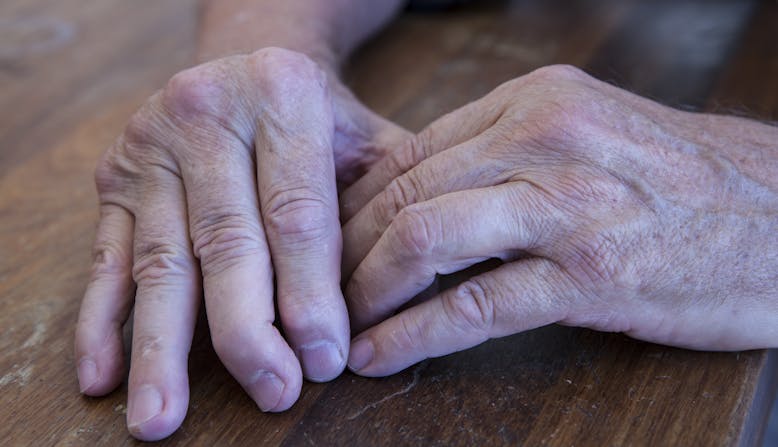Psoriatic arthritis (PsA) is a chronic, inflammatory disease of the joints and entheses, where tendons and ligaments connect to bone. Like psoriasis, PsA is associated with related health conditions (comorbidities).
About Psoriatic Arthritis
Psoriatic arthritis affects about 30% of people with psoriasis.
Did You Know?
Age of Onset of Psoriatic Arthritis
PsA can start at any age and may affect children. The disease often appears between ages 30 and 50. For many people, it starts about 10 years after psoriasis develops, but some develop PsA first or without ever developing or noticing psoriasis.
Psoriatic Arthritis Treatment
Though there is no cure, a growing range of treatments are available to help stop the disease progression, lessen pain, protect joints, and preserve range of motion. If you have or suspect you may have PsA, it is extremely important to work with a rheumatologist (a doctor who specializes in how the immune system affects joints, bones, and muscles) to find the right treatment plan. For help finding a rheumatologist near you, contact the Patient Navigation Center.
Early recognition, diagnosis, and treatment of PsA can prevent or limit the extensive joint damage that can occur in later stages of the disease.
Symptoms of PsA
Psoriatic arthritis symptoms can develop slowly with mild symptoms, or it can develop quickly and severely. Some people may develop PsA in a joint after an injury. Development may also be related to genetics. Scientists estimate that at least 10 percent of the general population inherits one or more of the genes that create a predisposition to psoriasis.
%20(12).png?ixlib=gatsbyFP&auto=compress%2Cformat&fit=max&rect=0%2C0%2C650%2C450&w=650&h=450)
Common Symptoms and Signs of Psoriatic Arthritis:
Here are eight common psoriatic arthritis symptoms and signs.
- Fatigue: it is common to experience PsA fatigue
- Enthesitis: tenderness, pain, and swelling over tendons
- Joint Swelling: swollen fingers and toes that sometimes resemble sausages
- Joint Pain: stiffness, pain, throbbing, swelling, and tenderness in one or more joints
- Reduced range of motion
- Morning stiffness and tiredness
- Nail changes: such as pitting or separation from the nail bed
- Eye inflammation: redness and pain in the eye (uveitis)
There is little connection between psoriasis severity and PsA severity. You could have few skin lesions but many joints affected by arthritis.
How PsA is Diagnosed
Unfortunately, there is no definitive diagnostic test for PsA. The diagnosis is made mostly by your doctor’s observations and by a process of elimination. For example, the symptoms of PsA are similar to those of rheumatoid arthritis, gout, and reactive arthritis. Your doctor will talk with you about your medical history and may perform a physical examination, blood tests, MRI, and X-rays.
If you think you might have PsA, take this short five-question screener. Share your results with your health care provider.
PsA Locations
PsA can occur in any joint or wherever your ligaments and tendons connect to bone. Learn more about the symptoms and signs of PsA, including spondylitis, enthesitis, and dactylitis.
What You Can Do
Treatments for PsA range from oral medications that reduce inflammation and swelling to biologic therapies that are injected or infused, while targeting specific parts of your immune system to combat PsA symptoms and slow joint damage.
You should see a rheumatologist to receive the highest standard of specialized care for your joints and connective tissues. Ask your health care provider to refer you to a rheumatologist or contact the Patient Navigation Center for help finding a rheumatologist in your area.
Life with PsA
The impact of PsA on your quality of life is similar to that of rheumatoid arthritis (RA). But there are significantly fewer resources for people living with PsA than there are for people with RA.
These inequalities in health resources have led to an unacceptable situation regarding PsA:
- Inadequate research
- Symptoms often misunderstood or not treated effectively
- Diagnoses often delayed
- Conflicting information that impacts the management of the disease
- Lack of understanding of how the disease can impact quality of life
- Too few rheumatologists with PsA knowledge and experience
Request Your PsA E-Kit
Learn more about PsA, its symptoms, treatment options, and ways to live a healthy life .
Frequently Asked Questions
Is Psoriatic Arthritis an Underlying Health Condition?
Yes, psoriatic arthritis is considered an underlying health condition as it is a chronic immune-mediated disease that affects the joints and skin. It is a form of inflammatory arthritis that develops in some people with psoriasis. This underlying condition requires ongoing management and treatment to control symptoms and prevent joint damage.
Is Psoriatic Arthritis Related to Ankylosing Spondylitis?
Psoriatic arthritis and ankylosing spondylitis are both types of inflammatory arthritis, but they have distinct characteristics. Psoriatic arthritis affects the skin and joints of people with psoriasis.
Ankylosing spondylitis mainly affects the spine and sacroiliac joints. It causes inflammation and pain. However, the family of spondyloarthritis diseases links both conditions, which have some common genetic and inflammatory pathways.
Is Psoriatic Arthritis Related to Blood Clots?
Psoriatic arthritis is not directly related to blood clots. Chronic inflammation in psoriatic arthritis can raise the risk of cardiovascular issues, like blood clots. Managing their condition effectively is important for individuals with psoriatic arthritis to reduce inflammation and minimize potential associated health risks.
By providing comprehensive and distinct information on these topics, individuals can gain a better understanding of psoriatic arthritis and its related aspects.
Last updated on 1/23/2025 by the National Psoriasis Foundation.
References
Mease, P. J., Gladman, D. D., Papp, K. A., Khraishi, M. M., Thaci, D., Behrens, F., . . . Alvarez, D. (2013). Prevalence of rheumatologist-diagnosed psoriatic arthritis in patients with psoriasis in European/North American dermatology clinics. J Am Acad Dermatol, 69(5), 729-735. doi:10.1016/j.jaad.2013.07.023
Photo of PsA in fingers courtesy of Dr. Evan Siegel.


.png?ixlib=gatsbyFP&auto=compress%2Cformat&fit=max&rect=12%2C0%2C1175%2C675&w=778&h=447)